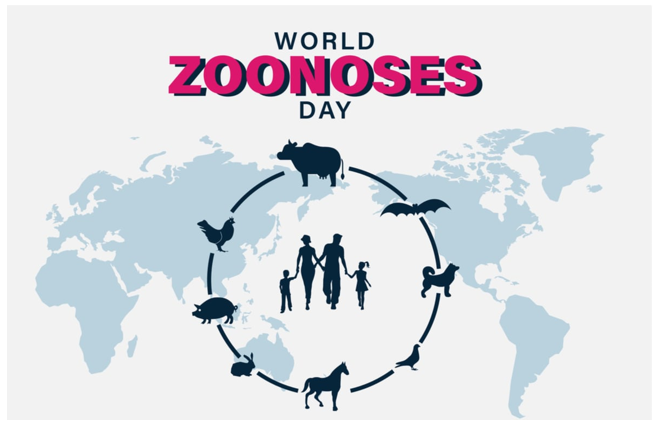- Courses
- GS Full Course 1 Year
- GS Full Course 2 Year
- GS Full Course 3 Year
- GS Full Course Till Selection
- Answer Alpha: Mains 2025 Mentorship
- MEP (Mains Enrichment Programme) Data, Facts
- Essay Target – 150+ Marks
- Online Program
- GS Recorded Course
- Polity
- Geography
- Economy
- Ancient, Medieval and Art & Culture AMAC
- Modern India, Post Independence & World History
- Environment
- Governance
- Science & Technology
- International Relations and Internal Security
- Disaster Management
- Ethics
- NCERT Current Affairs
- Indian Society and Social Issue
- NCERT- Science and Technology
- NCERT - Geography
- NCERT - Ancient History
- NCERT- World History
- NCERT Modern History
- CSAT
- 5 LAYERED ARJUNA Mentorship
- Public Administration Optional
- ABOUT US
- OUR TOPPERS
- TEST SERIES
- FREE STUDY MATERIAL
- VIDEOS
- CONTACT US
World Zoonosis Day
World Zoonosis Day
08-07-2023

Latest Context:
Recently on the occasion of World Zoonosis Day (6th July), the Department of Animal Husbandry and Dairying under the Ministry of Fisheries, Animal Husbandry and Dairying conducted an awareness program on zoonotic diseases.
More about the news:
- This program was organized with the aim to educate farmers about zoonotic disease risks as due to their close contact with animals, they are at higher risk of getting zoonotic diseases.
- The importance of "One Health" concept was also highlighted during the program.
About the World Zoonosis Day
- World Zoonosis Day is observed on July 6th each year.
- It is a global awareness campaign aimed at highlighting the risk of zoonotic diseases and their impact on human and animal health.
- Basically, the World Zoonosis Day marks the anniversary of the first vaccination against a zoonotic disease as on 6th July, 1885, the Louis Pasteur (French scientist) successfully administered the first vaccine for zoonotic disease.
- The day aims to educate and raise awareness among the general public, healthcare professionals, and policymakers about zoonotic diseases, their causes, and ways to prevent their spread.
- It emphasizes the importance of taking proactive measures to prevent and control these diseases to safeguard both human and animal populations.
- World Zoonosis Day serves as a reminder that zoonotic diseases pose a significant threat to public health and require a multidisciplinary approach involving veterinary, medical, and environmental professionals. It encourages collaboration and knowledge-sharing among these disciplines to enhance disease surveillance, prevention, and control strategies.
What are Zoonotic Diseases?
- Zoonotic diseases are infectious diseases that can be transmitted from animals to humans.
- These diseases can be caused by bacteria, viruses, parasites, fungi, or prions.
- Mostly, the zoonotic diseases occur through direct contact with infected animals, consumption of contaminated food or water, or exposure to vectors like mosquitoes and ticks.
Zoonotic diseases have been responsible for some major pandemics and epidemics throughout history. Examples of well-known zoonotic diseases include:
- Rabies: A viral disease transmitted through the bite or scratch of an infected animal, usually dogs. It affects the central nervous system and can be fatal if left untreated.
- Avian Influenza (Bird Flu): Caused by influenza viruses that primarily infect birds, but can occasionally infect humans. Certain strains of avian influenza have caused outbreaks with severe respiratory illness in humans.
- Ebola: A severe and often fatal viral disease that initially spreads from animals to humans. Fruit bats are believed to be the natural host of the virus, and it can also be transmitted through contact with infected animals or contaminated bodily fluids.
- Lyme Disease: Caused by the bacterium Borrelia burgdorferi, which is primarily transmitted to humans through the bite of infected black-legged ticks. It can cause a range of symptoms, including fever, fatigue, headache, and skin rash.
- Salmonellosis: A bacterial infection caused by the Salmonella bacterium, commonly associated with contaminated food, especially raw or undercooked poultry, eggs, and dairy products.
- COVID-19: The coronavirus disease 2019, caused by the SARS-CoV-2 virus, is a zoonotic disease which is believed to have originated in bats and possibly transmitted to humans through an intermediate animal host.
What are the ways to tackle zoonotic diseases?
- One Health Approach: Adopting a One Health approach involves collaboration and coordination between human health, animal health, and environmental sectors. It recognizes the interconnectedness of human, animal, and environmental health and promotes joint efforts to prevent and control zoonotic diseases.
- Disease Surveillance: To establish robust surveillance systems to monitor zoonotic diseases in animals and humans. Early detection and timely reporting of cases are crucial for effective disease control and prevention.
- Vaccination: Vaccination plays a vital role in preventing zoonotic diseases. Vaccinating animals against diseases like rabies, avian influenza, and brucellosis can reduce the risk of transmission to humans.
- Hygiene and Sanitation: Practicing good hygiene is essential to prevent zoonotic diseases. This includes regular handwashing with soap and water, especially after handling animals, visiting farms, or coming into contact with animal waste.
- Food Safety: Ensure food safety by handling and cooking food properly. Avoid consuming raw or undercooked meat, eggs, and unpasteurized dairy products. Proper storage and handling of food can minimize the risk of contamination.
- Vector Control: To control and manage vectors like mosquitoes and ticks, which can transmit zoonotic diseases. This can involve measures such as using insect repellents, wearing protective clothing, and implementing vector control programs.
- Animal Welfare and Biosecurity: Implement measures to promote animal welfare and prevent the spread of diseases within animal populations. This includes maintaining proper hygiene in animal housing, quarantining new animals, and implementing biosecurity protocols on farms and in veterinary clinics.
- Public Education and Awareness: Educate the public about zoonotic diseases, their transmission, and preventive measures. Promote awareness campaigns to inform people about the risks associated with handling animals, consumption of certain foods, and contact with wildlife.
- International Collaboration: Foster international collaboration and information sharing to address zoonotic diseases on a global scale. Cooperation between countries can help detect and respond to outbreaks promptly and effectively.
- Research and Innovation: Support research efforts to better understand zoonotic diseases, their transmission dynamics, and develop new tools for prevention, diagnostics, and treatments.
Conclusion
By implementing these prevention strategies, the risk of zoonotic disease transmission can be reduced, protecting both human and animal populations and promoting a healthier and safer environment.
Must Check: IAS Coaching Centre In Delhi



